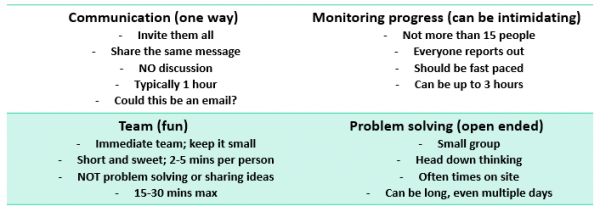Just this week, we had a company-wide training about meetings. From the research we’ve done, meetings are a source of frustration for most of the population. As a matter of fact, in just the last 20 short months, the number of meetings in the general world of business increased by nearly 70 percent. Who's got time for that? Not us, that’s for sure! Did you know, on average, meetings cost about $50 per hour per person? That adds up to an estimated $37 billion lost each year as a result of unproductive meetings.
Are you in the same boat, meeting-wise? Read on to see how we’re planning to spend less time around the virtual conference table and instead, make the meetings we do have more effective and productive.
Choose your meeting type:
Let’s start with assuming that there are four types of meetings. Full disclosure, this varies from resource to resource, but we chose these four because we felt like they fit with our team needs. It helps to define the meeting for team members because then they know what to expect and what expectations are for their participation.

Choose your attendees:
Who should be there? Start by inviting as few people as possible. Make sure it’s clear that everyone is there to do a job or have a part in the agenda. That brings us to the age-old question that everyone should be able to ask without fear or hesitation – do I really need to be there? As facilitators of meetings, make sure you’re receptive to this. Team members should feel empowered to ask if they need to be there. Maybe they do and the reason is just not clear or maybe they only need to be there for the first part of the agenda. Speak openly and respectfully when this comes up. And if several people are asking this, maybe pump the breaks on the meeting and re-evaluate if it really needs to take place.
Agenda and minutes:
If there is no agenda, don’t have the meeting. Use your agenda as an opportunity to set the tone for the meeting and be clear about the desired outcomes. Put your partial attendees (special guests, as we like to call them at Fundriver), at the front of the agenda so they can get out of there once they’re done. Be reasonable about the amount of time each item on the agenda is going to take and then stick to the plan! Recruit a timekeeper to help if you need one. Use your agenda to record action items. There really is no need for minute-by-minute details anymore. Keep your team accountable, send the minutes or action items RIGHT AFTER THE MEETING. Do not wait – why? Because it shows that this is important to you and reminds attendees that they just participated in something that resulted in meaningful action.
Here's one last pro tip we wanted to share. A simple way to trim down on the length of meetings is to have an unusual start time. If you’re trying to trim from 60 minutes to 45 minutes, for example, don’t start at the top of the hour, start at quarter past It is proven to be effective on shortening meetings and helping any chronic late comers remember to arrive on time.
There you have it! Our Reader’s Digest version of our training from this week – and we didn’t even make you meet with us on it!